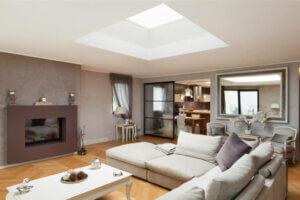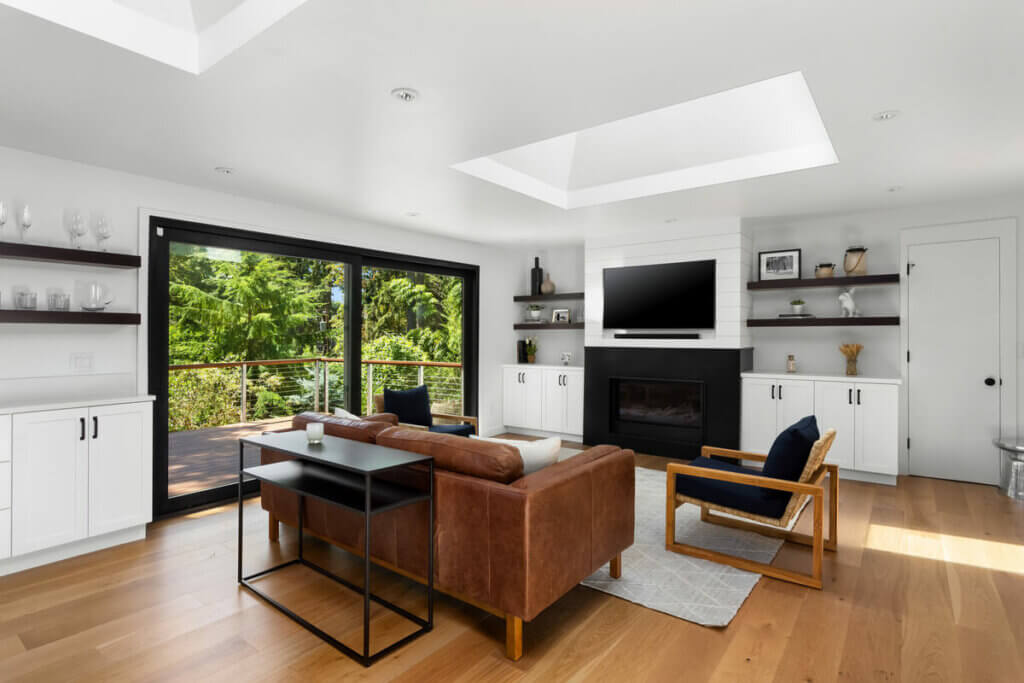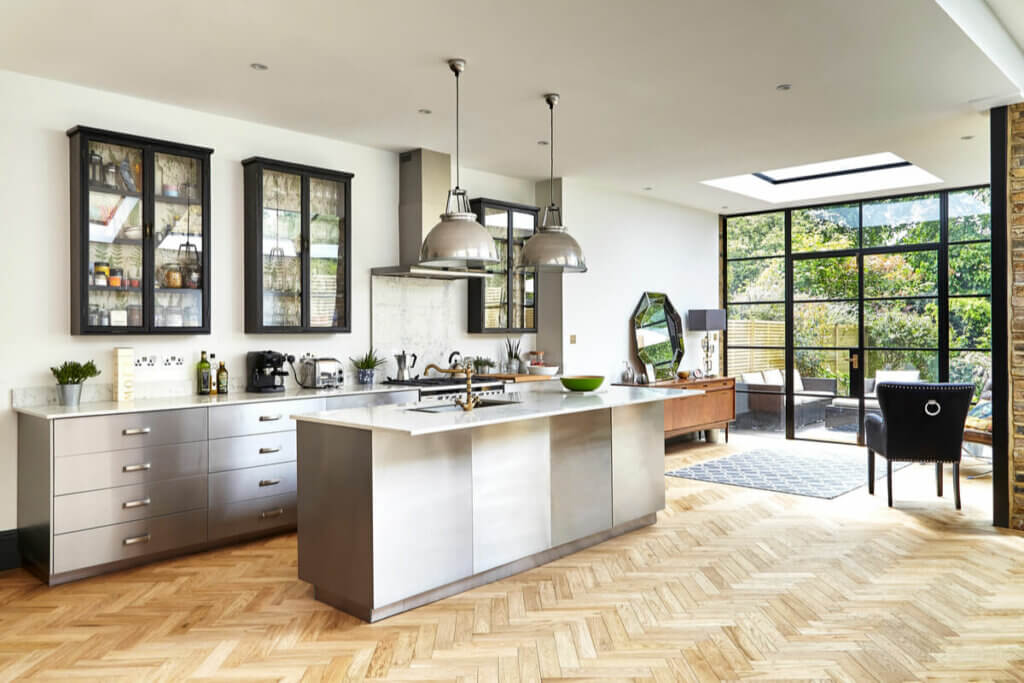The Aesthetic Effect of Skylights in the Home

Interiors should produce different sensations. Through the decoration and the design itself, you can bring a personal touch to the whole, but there are always small details that add a certain something. Let’s examine the aesthetic effect of skylights in the home.
These installations are not that common. Obviously, a series of structural conditions are necessary to install them, hence they’re more common in country houses, in attics, or other isolated spaces.
Originality in interiors is developed through the use of certain components. In this case we’re talking about applying concepts that are not generally used. It’s a way to stand out and work not only with materials and shapes but also with light and space.
Where are they usually located?

Typically, skylights have a functional capacity within a room. They provide natural lighting from outside. They’re made of glass with a metal frame that acts as a barrier to the cold.
The upper spaces of the house are usually candidates for the installation of skylights, for example, in bedrooms, living rooms, or lounges. Light is available continuously throughout the day, which means less use of artificial lights is required.
However, it’s also possible to find skylights in inside rooms that open onto other rooms, patios, or other such spaces that probably don’t provide the same lighting as the outdoors. In any case, it’s a good idea to include these openings, which contribute to a healthy environment.
The location of skylights demonstrates the option of connecting interiors with exteriors in a more direct way.
The aesthetic effect of skylights
How can skylights contribute to the home? As a structural component, they aren’t central to the aesthetic but still play an important role in the decoration. Let’s take a look at some of their qualities:
- The first thing to understand is that skylights can be of different sizes. Small and narrow ones fit into any roof and, on the other hand, larger ones create a considerable opening for light to pour through as if the whole house was open.
- The light that they let inside generates calm and tranquility. People need exposure to natural lighting on a daily basis, especially in rooms such as the living room where we spend a lot of time. It improves our mood.
- Skylights enhance the other decorative elements of a space: vases, sculptures, furniture, etc. In fact, they act as natural spotlights from above and radiate light downward, causing it to spread throughout the whole room.
- There is no doubt that rooms feel more natural under a skylight. It’s as if there were a window open to nature; as if the house merges with the outdoors.
A way to enhance colors

Sometimes the colors of the walls or furniture don’t show the richness and strength they really have. This is due to the absence of proper lighting. For this reason, it can be a great idea to use skylights in the home.
Don’t forget that natural light allows us to see interiors in a natural way. The elegance and gentleness of the decoration stand out as long as we think about the space from different points of view.
To sum up, we’re talking about the concept of harmony. This can be achieved through a generalized dialogue.
A modern effect
Although skylights have been used in the past, they also create a modern feeling, giving a more spontaneous effect with a more bohemian touch.
Due to their shape and design, they’re a simple, basic element that can produce an innovative, different, and subtle aesthetic meaning, something that can’t be produced by normal windows in walls.
In short, the contribution skylights make in a house is really interesting. Not only are they functional, but they also enhance the interior design aesthetics.
Interiors should produce different sensations. Through the decoration and the design itself, you can bring a personal touch to the whole, but there are always small details that add a certain something. Let’s examine the aesthetic effect of skylights in the home.
These installations are not that common. Obviously, a series of structural conditions are necessary to install them, hence they’re more common in country houses, in attics, or other isolated spaces.
Originality in interiors is developed through the use of certain components. In this case we’re talking about applying concepts that are not generally used. It’s a way to stand out and work not only with materials and shapes but also with light and space.
Where are they usually located?

Typically, skylights have a functional capacity within a room. They provide natural lighting from outside. They’re made of glass with a metal frame that acts as a barrier to the cold.
The upper spaces of the house are usually candidates for the installation of skylights, for example, in bedrooms, living rooms, or lounges. Light is available continuously throughout the day, which means less use of artificial lights is required.
However, it’s also possible to find skylights in inside rooms that open onto other rooms, patios, or other such spaces that probably don’t provide the same lighting as the outdoors. In any case, it’s a good idea to include these openings, which contribute to a healthy environment.
The location of skylights demonstrates the option of connecting interiors with exteriors in a more direct way.
The aesthetic effect of skylights
How can skylights contribute to the home? As a structural component, they aren’t central to the aesthetic but still play an important role in the decoration. Let’s take a look at some of their qualities:
- The first thing to understand is that skylights can be of different sizes. Small and narrow ones fit into any roof and, on the other hand, larger ones create a considerable opening for light to pour through as if the whole house was open.
- The light that they let inside generates calm and tranquility. People need exposure to natural lighting on a daily basis, especially in rooms such as the living room where we spend a lot of time. It improves our mood.
- Skylights enhance the other decorative elements of a space: vases, sculptures, furniture, etc. In fact, they act as natural spotlights from above and radiate light downward, causing it to spread throughout the whole room.
- There is no doubt that rooms feel more natural under a skylight. It’s as if there were a window open to nature; as if the house merges with the outdoors.
A way to enhance colors

Sometimes the colors of the walls or furniture don’t show the richness and strength they really have. This is due to the absence of proper lighting. For this reason, it can be a great idea to use skylights in the home.
Don’t forget that natural light allows us to see interiors in a natural way. The elegance and gentleness of the decoration stand out as long as we think about the space from different points of view.
To sum up, we’re talking about the concept of harmony. This can be achieved through a generalized dialogue.
A modern effect
Although skylights have been used in the past, they also create a modern feeling, giving a more spontaneous effect with a more bohemian touch.
Due to their shape and design, they’re a simple, basic element that can produce an innovative, different, and subtle aesthetic meaning, something that can’t be produced by normal windows in walls.
In short, the contribution skylights make in a house is really interesting. Not only are they functional, but they also enhance the interior design aesthetics.
All cited sources were thoroughly reviewed by our team to ensure their quality, reliability, currency, and validity. The bibliography of this article was considered reliable and of academic or scientific accuracy.
- Emma, Callery: Enciclopedia práctica de la decoración, Everest, 2001.
- Walton, Stewart: Guía completa de decoración: 1000 ideas de diseño para el hogar, Blume, 1997.







